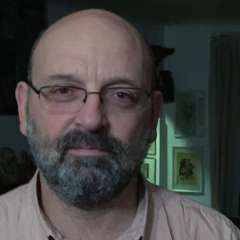A quarter of a century old and often revived, San Francisco Opera' staging of Puccini’s Turandot – a co-production with the Lyric Opera of Chicago – has barely aged. With decors freshly repainted and carefully illuminated, it is as attention grabbing as ever. The set itself is a true artwork, very much related to David Hockney’s other paintings from the same decade, as seen in the traveling retrospective, currently at the Metropolitan Museum in New York, celebrating the artist’s 80th birthday. Hockney's works are very much anchored in the realm they are trying to epitomize: native Yorkshire, adopted South California, Turandot’s tale.
Always innovative, Hockney's tableaux are rooted in art history. The palace in the opera’s first act is made of a series of twisted structures. Indicative of the plot, walls are flame-red and roofs are in a shade of blue-green, the color of light refracted by a fault in a glacier’s surface. The second act pavilion, where the ministers Ping, Pong and Pang are conferring before dawn, is represented by a huge screen on which appear Song dynasty-inspired images with birds and mountainous landscapes but also several isolated Matisse-like chairs that convey the impression of depth. The thickets in the nocturnal garden scene are as stylized as Miró’s biomorphic forms.
Ian Falconer’s costumes for the main characters, using brilliant hues and abstracted decorative patterns, match very well the scenography and are even more brought to fore by contrast with the traditional black of the choristers. That doesn’t mean that the overall pictorial harmony is not disturbed by several minor exaggerations such as the psychedelic grinding wheel or the aged sumo fighter look of the members of the executioner’s retinue. Unfortunately, Hockney’s outstanding décor is not matched by Garnett Bruce’s conventional stage direction. Singers are treading up and down the staircases with utmost solemnity and plant their feet well apart when they need to utter their sounds. At one point, the emperor, slumped in a black unadorned lectica, is unceremoniously pulled backstage, facing the crowd. Lawrence Pech’s choreographic inserts, with awkward acrobatic jumps and fleeting banners, seemed as outdated.
Turandot was the marvelous Swedish soprano Nina Stemme, who brought to the role true Wagnerian heft. Her voice was a little stretched in the upper register, but she produced a wonderfully focused, intense, steely sound as the menacing princess. It was not a one-dimensional portrait. She sounded more pained than revengeful during “In questa reggia”, the aria in which she recalls her wronged ancestor. Her assuredness melting while Calaf answers, one by one, her riddles, Stemme’s voice acquired an anguished dimension when pleading with the Emperor not to surrender her to the stranger. Of course, not even as talented actress as Stemme can easily make believable the abrupt final transformation of the character, the libretto’s biggest weakness, but she tried her best. American spinto tenor Brian Jagde, a former San Francisco Opera Adler fellow, was a remarkable Calaf, perfectly rendering the prince’s unwavering confidence. Uniformly powerful across the entire spectrum, his voice may soon be ready for significant Wagnerian challenges. His duets with Stemme were well balanced but Jagde somehow missed the lyrical strain of “Nessun dorma”.
As self-sacrificing Liù, the vibrant soprano Leah Croccetto rendered with ease and expressiveness the character’s vulnerability and determination, the pathos in Puccini melodic line. In smaller roles, bass Soloman Howard showed great promise in portraying a dignified Timur and Joo Won Kang, Julius Ahn and Joel Sorensen as Ping, Pang and Pong formed a well-coordinated singing and acting trio.
In his debut at the San Francisco Opera, conductor Christopher Franklin tried to confer, as Hockney did, three-dimensionality to a work that is dramatically quite flat. Using the standard Alfano ending, he didn't push the bombastic moments and accentuated avant-garde sonorities. The orchestra and chorus responded well to his demands.
At the curtain call, Hockney himself was presented with the San Francisco Opera Medal, the company’s highest honor. If, in time, this strong vocal and orchestral performance will fade away from the public’s memory, Hockney’s images will not.


